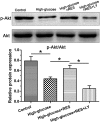Resveratrol attenuates high glucose-induced nucleus pulposus cell apoptosis and senescence through activating the ROS-mediated PI3K/Akt pathway
- PMID: 29273676
- PMCID: PMC5897744
- DOI: 10.1042/BSR20171454
Resveratrol attenuates high glucose-induced nucleus pulposus cell apoptosis and senescence through activating the ROS-mediated PI3K/Akt pathway
Retraction in
-
Retraction: Resveratrol attenuates high glucose-induced nucleus pulposus cell apoptosis and senescence through activating the ROS-mediated PI3K/Akt pathway.Biosci Rep. 2024 Aug 28;44(8):BSR-2017-1454_RET. doi: 10.1042/BSR-2017-1454_RET. Biosci Rep. 2024. PMID: 39171816 Free PMC article. No abstract available.
Abstract
Background: Diabetes mellitus is closely correlated with disc degeneration. Nucleus pulposus (NP) cell apoptosis and senescence are typical cellular features within the degenerative disc. Resveratrol is a newly identified phytoalexin that has protective effects on cartilaginous tissue.
Objective: To investigate the whether resveratrol can protect against high glucose-induced NP cell apoptosis and senescence, and the potential mechanism in this process.
Methods: Rat NP cells were cultured in either 10% FBS culture medium (control group) or 10% FBS with a high glucose concentration (0.2 M, experiment group) for 3 days. Resveratrol or the combination of resveratrol and LY294002 was added into the culture medium of experiment group to investigate the effects of resveratrol and the PI3K/Akt pathway.
Results: High glucose significantly promoted NP cell apoptosis and NP cell senescence compared with the control group. Resveratrol exhibited protective effects against high glucose-induced NP cell apoptosis and senescence. Further analysis showed that resveratrol suppressed reactive oxygen species (ROS) generation and increased the activity of the PI3K/Akt pathway under the high glucose condition. However, the LY294002 had no significant effects on ROS content in the resveratrol-treated high glucose group.
Conclusion: Resveratrol can attenuate high glucose-induced NP cell apoptosis and senescence, and the activation of ROS-mediated PI3K/Akt pathway may be the potential mechanism in this process.
Keywords: apoptosis; glucose; intervertebral disc degeneration; nucleus pulposus; resveratrol; senescence.
© 2018 The Author(s).
Conflict of interest statement
The authors declare that there are no competing interests associated with the manuscript.
Figures





Similar articles
-
Resveratrol inhibits IL-1β-mediated nucleus pulposus cell apoptosis through regulating the PI3K/Akt pathway.Biosci Rep. 2019 Mar 26;39(3):BSR20190043. doi: 10.1042/BSR20190043. Print 2019 Mar 29. Biosci Rep. 2019. Retraction in: Biosci Rep. 2024 Aug 28;44(8):BSR-2019-0043_RET. doi: 10.1042/BSR-2019-0043_RET. PMID: 30867252 Free PMC article. Retracted.
-
Bone morphogenetic protein-7 retards cell subculture-induced senescence of human nucleus pulposus cells through activating the PI3K/Akt pathway.Biosci Rep. 2019 Mar 19;39(3):BSR20182312. doi: 10.1042/BSR20182312. Print 2019 Mar 29. Biosci Rep. 2019. Retraction in: Biosci Rep. 2024 Aug 28;44(8):BSR-2018-2312_RET. doi: 10.1042/BSR-2018-2312_RET. PMID: 30787052 Free PMC article. Retracted.
-
Nucleus pulposus cell senescence is alleviated by resveratrol through regulating the ROS/NF-κB pathway under high-magnitude compression.Biosci Rep. 2018 Jul 6;38(4):BSR20180670. doi: 10.1042/BSR20180670. Print 2018 Aug 31. Biosci Rep. 2018. Retraction in: Biosci Rep. 2024 Aug 28;44(8):BSR-2018-0670_RET. doi: 10.1042/BSR-2018-0670_RET. PMID: 29875176 Free PMC article. Retracted.
-
Resveratrol enhances matrix biosynthesis of nucleus pulposus cells through activating autophagy via the PI3K/Akt pathway under oxidative damage.Biosci Rep. 2018 Jul 6;38(4):BSR20180544. doi: 10.1042/BSR20180544. Print 2018 Aug 31. Biosci Rep. 2018. Retraction in: Biosci Rep. 2024 Aug 28;44(8):BSR-2018-0544_RET. doi: 10.1042/BSR-2018-0544_RET. PMID: 29752339 Free PMC article. Retracted.
-
Modulation of the PI3K/Akt signaling pathway by resveratrol in cancer: molecular mechanisms and therapeutic opportunity.Discov Oncol. 2025 May 5;16(1):669. doi: 10.1007/s12672-025-02471-w. Discov Oncol. 2025. PMID: 40323335 Free PMC article. Review.
Cited by
-
Molecular mechanisms of alveolar epithelial cell senescence and idiopathic pulmonary fibrosis: a narrative review.J Thorac Dis. 2023 Jan 31;15(1):186-203. doi: 10.21037/jtd-22-886. Epub 2022 Dec 27. J Thorac Dis. 2023. PMID: 36794134 Free PMC article. Review.
-
Resveratrol inhibits IL-1β-mediated nucleus pulposus cell apoptosis through regulating the PI3K/Akt pathway.Biosci Rep. 2019 Mar 26;39(3):BSR20190043. doi: 10.1042/BSR20190043. Print 2019 Mar 29. Biosci Rep. 2019. Retraction in: Biosci Rep. 2024 Aug 28;44(8):BSR-2019-0043_RET. doi: 10.1042/BSR-2019-0043_RET. PMID: 30867252 Free PMC article. Retracted.
-
Bone morphogenetic protein-7 retards cell subculture-induced senescence of human nucleus pulposus cells through activating the PI3K/Akt pathway.Biosci Rep. 2019 Mar 19;39(3):BSR20182312. doi: 10.1042/BSR20182312. Print 2019 Mar 29. Biosci Rep. 2019. Retraction in: Biosci Rep. 2024 Aug 28;44(8):BSR-2018-2312_RET. doi: 10.1042/BSR-2018-2312_RET. PMID: 30787052 Free PMC article. Retracted.
-
Osteogenic protein-1 attenuates nucleus pulposus cell apoptosis through activating the PI3K/Akt/mTOR pathway in a hyperosmotic culture.Biosci Rep. 2018 Dec 14;38(6):BSR20181708. doi: 10.1042/BSR20181708. Print 2018 Dec 21. Biosci Rep. 2018. Retraction in: Biosci Rep. 2024 Aug 28;44(8):BSR-2018-1708_RET. doi: 10.1042/BSR-2018-1708_RET. PMID: 30459239 Free PMC article. Retracted.
-
Platelet-Derived Biomaterials Exert Chondroprotective and Chondroregenerative Effects on Diabetes Mellitus-Induced Intervertebral Disc Degeneration.Life (Basel). 2021 Oct 7;11(10):1054. doi: 10.3390/life11101054. Life (Basel). 2021. PMID: 34685425 Free PMC article.
References
Publication types
MeSH terms
Substances
LinkOut - more resources
Full Text Sources
Other Literature Sources
Miscellaneous

